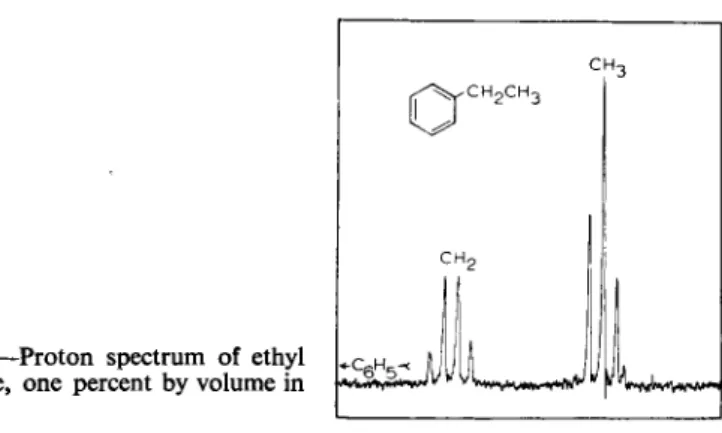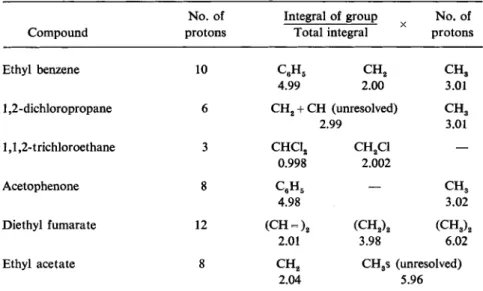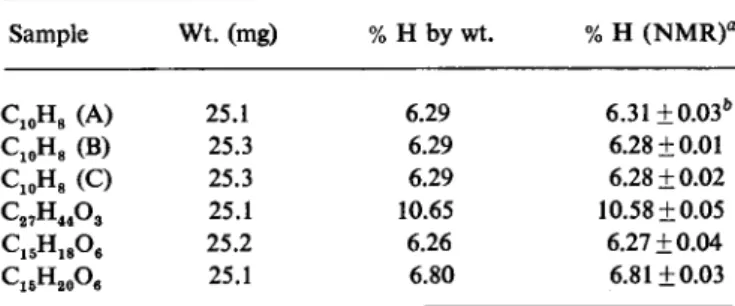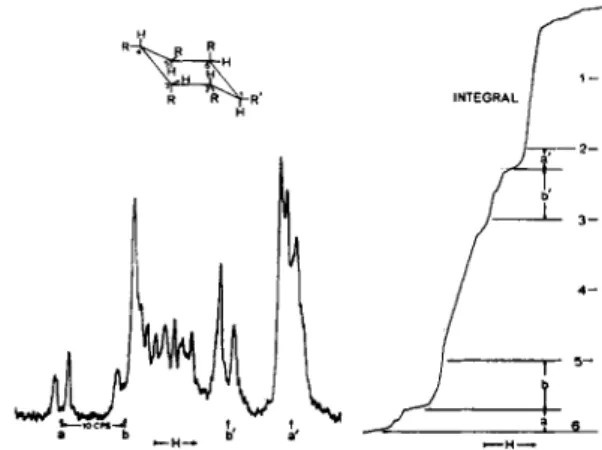Recent instrumental improvements in high resolution N M R spectrometers, including audio-frequency modulation and phase-sensitive detection [4, 8, 9], thermal isolation of the magnet and control of its temperature, and careful attention to optimization of receiver noise figure and coil configuration, have permitted steady improvement in the sensitivity of these instruments. Fig. 1 shows the proton spectrum of a 1 per cent solution of ethyl benzene in a cylindrical glass cell of 4 mm internal diameter, taken at an operating fre
quency of 60 M c in a magnetic field of approximately 14,100 oersteds. The weakest peak in the quartet represents approximately ^ of the intensity arising from the two protons in the C H2 groups, which corresponds to one proton per molecule in a 0.016 Μ solution. Since the volume of solution in the cell is typically 0.4 ml,1 this means that a substance of molecular weight 300 can be studied effectively with as little as 2 mg of sample.
A s an example of the type of structural information that can be obtained with small amounts of sample, let us consider an unknown steroid i l l ) resulting from a microbiological transformation of testosterone ( I ) , and available in 2 mg quantity. Chemical evidence [5] suggested that hydroxyla- tion at C1 2 or C1 8 had taken place. The N M R spectrum, shown in Fig. 2, proved to be quite informative when compared with the spectrum of the parent compound testosterone. Both compounds were studied in CDC13 solution to which a trace of tetramethysilane had been added to serve as an internal reference compound. Chemical shifts are indicated in Fig. 2 over
II
1 The volume can be reduced somewhat if cells with special configurations are con
structed. Although the cell should be an ellipsoid of revolution to avoid disturbing the magnetic field homogeneity, a cylindrical cavity with length/diameter ratio 4:1 or greater appears to give satisfactory resolution with about half the standard volume of solution.
Fig. 1.—Proton spectrum of ethyl benzene, one percent by volume in CC14.
' 6M5
the corresponding peaks and expressed in parts per million of the applied magnetic field according to the definition
VsiMe,
where the expression in parentheses is just the frequency separation of the peaks as measured by the well known side-band method and vsiMe, is 60 M c .
The presence of two strong angular methyl peaks at δ = 1.13 and 1.23 shows that C1 8 cannot be hydroxylated. Moreover, in addition to the triplet with δ = 3.72 which is due to the proton on C1 8 and is found in both I and I I , one other proton in I I is found to be shifted to δ = 4.41, indicating attach
ment of the hydroxyl to a ring. Observations of the 11 α-proton in four 11/Miydroxylated steroids [10] average to δ = 4.43,1 but the hydroxyl group
0.00 —
Fig. 2.—Spectrum of 2 mg of zl4,14-androstadiene-17/?, 12a-diol-3-one.
1 Since the measurements of reference [10] were reported in cps relative to benzene in an external annular cell at 40 Mc, it is necessary for comparison purposes to convert to the present scale by the relation
^(ppm) = (385-3/2 vt (40 Mc))/60
atoms as a function of dihedral angle (after Conroy).
0 2 0 4 0 6 0 8 0 100 120 140 160 180
cannot be in the 11 ^-position because in that case it would shift the C1 9 peak from the value ό = 1.23 observed in testosterone to approximately 1.50 (see [10]). However, the 12a-position for the hydroxyl would result in the 12^-proton bearing essentially the same equatorial relationship to the molecule as an 1 Ια-proton. The angular methyl resonances would not be affected appreciably by a 12a-hydroxyl directed axially away on the reverse side of the molecule.
The closely spaced triplet at δ = 5.48 shows that while the peak at δ = 5.71 due to the olefinic proton on C4 is unchanged, a new trisubstituted double bond has been introduced. The triplet structure indicates two neighboring protons on an adjacent carbon atom. Since the Α-ring is apparently un
changed, according to the peak at 5.71, the new double bond can be located only from C7 to C8, C9 to Cn, or from C1 4 to C1 5. The A9 ( 1 1 )-group would, however, shift the C1 9 peak by more than 0.1 ppm beyond the δ = 1.23 value observed for both I and I I . The A7-group does not appreciably affect C1 8, while a A1 4-group has been found (11) to shift C1 8 by 0.27 ppm. Since the C1 8 resonance in I I falls at 1.13 while in I it occurs at 0.82, the double bond has apparently been introduced at C1 4 and I I must be A4 1 4- a n d r o - stadiene-17/8, 12a-diol-3-one.
Recent calculations by Karplus [6] and Conroy [2] have provided a firm basis for establishing molecular conformation from measurements of spin- spin coupling between protons on adjacent carbon atoms. A n approximate reproduction of Conroy's results1 is shown in Fig. 3. The dependence of the spin coupling, JHH, on the dihedral angle between the two planes con
taining the carbon atoms and a proton is in agreement with numerous obser
vations that in 6-membered ring systems the coupling between two adjacent axial protons is typically 8-11 cps while between an axial and equatorial, or two equatorial protons, the coupling diminishes to 2-3 cps.
1 Permission to reproduce these results from the work of Dr. Harold Conroy, Yale University, New Haven, Conn., is gratefully acknowledged.
MZ My
Fig. 4.—1,4-dinitroinositol tetra
acetate in CDClo. Hy H
z
A striking example of the structural deductions which can be based upon this spin-coupling behavior is shown in Fig. 4. One of the possible isomers of 1,4-dinitroinositol tetra-acetate was investigated with the aim of deter
mining its structure and conformation.1 The strong, sharp peaks at the right- hand end of the spectrum indicate that the four acetate methyl groups are equivalent in pairs. The six ring-protons fall into three spin-spin multiplet patterns labelled HX9 HY, and Hz and are thus also equivalent in pairs. A center or plane of symmetry is therefore suggested.
The groups HY and Hz both display a large splitting characteristic of axial-axial spin-coupling and a smaller coupling which must be due to adjacent axial and equatorial protons. Therefore, HY and Hz together repre
sent four axial protons, and Hx represents two equatorial protons.
Assume for the moment that the nitro groups are not equatorial, as shown in Fig. 4, but axial. Then the protons on the same carbon atom would be the equatorial protons, Hx, and the remaining four protons would all be axial. This, however, requires the four acetate groups to be equatorial and equivalent which is contrary to observation.
Since the nitro groups have been shown to be equatorial, the protons on the same carbon atom are axial, either ΗY or Hz. Each has one axial and one equatorial neighbor. The other axial protons also display a spin- coupling pattern indicative of one axial and one equatorial neighbor. These conditions and the equivalence in pairs of the three sets of protons can only be satisfied by the structure shown in Fig. 4 which possesses a center of symmetry.
While the analysis of chemical shifts and spin-spin coupling constants as exemplified by the preceding examples has been given much attention, quantitative measurements have often been neglected due to the more severe
1 This work has been discussed in greater detail and submitted for publication else
where by S. W . Lichtenthaler and H. O. L. Fischer, Dept. of Biochemistry, University of California, Berkeley, Calif.
The peak height of the absorption signal is given by
^ (const) Mp H1T2
m a x l + iyHtfTiTi
(where Mo — net nuclear magnetic moment; Hx = exciting radio frequency magnetic field; γ = magnetogyric ratio; Tx = spin lattice relaxation time; and T2 = spin-spin relaxation time), and since T2 is inversely proportional to line width, peak height measurements are useful only if the lines are of identical width. On the other hand, the integral with respect to a magnetic field sweep is
(const) M0 Ηλ jvdH-
The net nuclear magnetic moment, Mo, depends both upon the number of nuclei/unit volume, N, and upon the excess population in the lower Zeeman level which, at room temperature, is inversely proportional to the absolute temperature, T. Furthermore, it is usually advantageous to integrate as a function of time; thus
r (const) HXN
JVdt ~ T(dH/dt) [l + tyHtf^TJi1'*'
The preceding equations are valid only for slow passage conditions which, in high resolution work, are rarely, if ever, met. They predict that, for power levels which give reasonable instrument performance and for typical values of 7\ and T2 (a few seconds), the integrals may very well depend upon the relaxation times.
Measurement of the relaxation times is laborious and since the slow passage conditions are seldom met anyway, corrections are difficult to apply.
It appears more profitable, therefore, to seek conditions which would lead to independence from the effects of relaxation. Examination of the term leading to "saturation", i.e. (1 + (γΗ-^ΤχΤ^-*, suggests that it is pro
portional to the decrease in the excess population of the lower Zeeman level over the time interval, Tl9 required for slow passage during which transitions
Fig. 5.—Block diagram of N M R in
tegrating system.
BLOCK D I A G R A M O F NMR INTEGRATOR
occur with probability (γΗ^2Τ2. A simple modification of the equation which should make it more valid for rapid passage through resonance is to replace the time Tx by the actual time of passage, ΔΗ/dH/dt. Since the line width, Δ 7/, is \/γΤ2 we have then
r , (const) ΗΛ Ν γλ λ ι τ τ 2 ,,, τ τ ι j ν , ,
! v d t =
ndH/dt) v-^yHi/{dH/dt)+.-]
for yH\/(dH/dt)<\.
This equation predicts that even at high r.f. power levels the integrals can be made to be
independent
of relaxation times for sufficiently fast sweep rates.It would appear that a signal-to-noise problem might arise since, in order to keep γΗΐ/dH/dK 1 an «-fold increase in sweep rate can only be ac
companied by a //i-fold increase in Hl9 resulting in an integral smaller by Ϋη. However, the faster sweep permits obtaining η-times as many observa
tions per unit time, and statistical averaging of these η observations restores a factor Vn in the reliability of the result. It is often convenient to use a digital voltmeter when a large number of observations are desired, rather than measuring from a strip chart recording.
Increasing the sweep rate to about 5 cps/sec for integrating, instead of the usual 1-2 cps/sec rate for recording the absorption spectrum, reduces the errors due to random drifts in the magnetic field correspondingly. This has permitted integration accuracy better than 1 per cent without any difficulty from this source of instability. Another source of error must be eliminated, however, before such accuracy can be achieved with weak signals. This is due to variation in the D.C. output of the r.f. detector due to instabilities in probe balance, transmitter power level changes, and stray coupling in leads. Fortunately, this problem is greatly reduced by the use of audio-frequency modulation of the magnetic field at a frequency of one
21 -60143045 I & Μ
1,1,2-trichloroethane 3 CHC12 CH2C1 — 0.998 2.002
Acetophenone 8 CeH5 — C H ,
4.98 3.02
Diethyl fumarate 12 (CH = )2 ( C H2)2 ( C H3)a
2.01 3.98 6.02
Ethyl acetate 8 C H2 CH3s (unresolved)
2.04 5.96
Fig. 6.—Integrated intensities of distinguishable groups of protons expressed as a frac- tion of the total intensity.
or two thousand cps. Several authors [1, 3, 9] have discussed the effect of such modulation on the N M R signals. A set of audiofrequency side bands are obtained along with an audio-frequency signal at the usual field strength.
By suitable adjustment of modulation amplitude and audiofrequency phase, the side bands can be essentially completely rejected by a phase-sensitive detector while the center-band signal, now free from low frequency drifts after traversing an R C coupling circuit, is converted back to D.C. and recorded or integrated. A block diagram is shown in Fig. 5.
The strong signals from pure compounds provide a convenient test for the linearity of the entire system of r.f. amplifiers, detector, audio-amplifier, phase detector and integrator. Fig. 6 shows the relative intensities of signals from various groups of protons in pure organic liquids. In nearly every case the ratios of the measured integrals agree with those calculated from the molecular formulae to better than 0.5 per cent.
A more stringent test is the analysis of small samples (25 mg) for total hydrogen. In this case the unknown samples are compared with a standard, using tubes with identical cross sectional areas. Fig. 7 shows the results of comparing three complex natural products against napthalene as a standard.
The napthalene was run in triplicate to establish the precision of the measure- ment. The percentage of hydrogen by weight agrees in nearly all cases with the calculated value to within the standard deviation of the measurement, which is about 0.5 per cent of the percentage present. This accuracy, and
Total hydrogen analyses by NMR for complex organic molecules.
Sample Wt. (mg) % Η by wt. % Η ( N M R f
C1 0H8 ( A ) 25.1 6.29 6.31±0.03&
C1 0H8 (B) 25.3 6.29 6.28 ±0.01
C1 0H8 (C) 25.3 6.29 6.28 ±0.02
C2 7H4 4Og 25.1 10.65 10.58 ±0.05
C1 5H1 8Oe 25.2 6.26 6.27 ±0.04
C1 5H2 0O6 25.1 6.80 6.81 ±0.03
a Based on average integral of naphthalene solutions.
b Standard deviation.
Fig. 7.—Total integrals compared with weight percent hydrogen for several compounds in identical sample cells.
the non-destructive nature of the analysis, may make the N M R method more attractive than the usual combustion method when a limited amount of sample is available.
A s an example of the analytical possibilities of the technique, a mixture of steroids with isomeric double bonds was studied. Fig. 8 shows the separate signals obtained from the olefinic proton on the 5-membered ring and the terminal methylene protons. Electronic integration of this portion of the spectrum established the relative amounts of the isomers to the nearest percent, reproducible in separate sample preparations.
Finally, the use of intensity measurements to arrive at and confirm an assignment of spectral lines is illustrated in Fig. 9. Each carbon atom of the cyclohexane ring has one proton. A large number of configurational and conformational isomers are possible. However, the presence of a typical small-large-large-small pattern characteristic of two protons with a small chemical shift and a comparable spin-coupling constant [7] is confirmed by
A N A L Y S I S OF A S T E R O I D M I X T U R E
Fig. 8.—Analysis of a mixture of isomers.
Fig. 9.—Confirmation of spectral asignments using quantitative information.
the integral curve. Fig. 9 shows that the right hand peak in the spectrum is larger than the value corresponding to § of the total intensity by an amount just equal to the area of the doublet, a, on the left. Therefore, it conceals a similar doublet, d. The large spin-coupling, 10 cps, requires two adjacent axial protons, while the doubling of each line of the pattern with a much smaller spacing shows that each axial proton has an equatorial neighbor.
This sequence of protons occurs only for the particular isomer and con
formation shown in Fig. 9; consequently, all other structures which were under consideration could be eliminated.
Accurate area measurements of N M R signals have proven so useful in the applications described in this paper and in a host of other problems that this capability can be regarded as almost essential. The analytical usefulness of the instrument is so greatly extended that there can be little doubt that widespread application to problems in research and routine analysis will
result.
R E F E R E N C E S 1. ANDERSON, W. Α., Phys. Rev. 102, 151 (1956).
2. CONROY, H. (private communication).
3. HALBACH, K . , Helv. Phys. Acta 27, 259 (1954).
4. ibid. 29, 37 (1956).
5. HERZOG, H. L., GENTLES, J. J., BASCH, Α., COSCURELLI, W., ZEITZ, Μ. E. A . and CHARNEY, W . (submitted for publication).
6. KARPLUS, M., /. Chem. Phys. 30, 11 (1959).
7. POPLE, J. Α., BERNSTEIN, H. J. and SCHNEIDER, W. G., High Resolution Nuclear Magnetic Resonance, pp. 119-123. McGraw-Hill Book Co., New York, 1959.
8. POUND, R. V., Rev. Sci., Inst. 28, 966 (1957).
9. PRIMAS, H., Helv. Phys. Acta 31, 17 (1958).
10. SHOOLERY, J. N. and ROGERS, Μ. T . , /. Am. Chem. Soc. 80, 5121 (1958).
11. SLOMP, G. (private communication).




